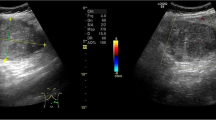Abstract
Adnexal torsion is an uncommon cause of severe lower abdominal pain in women and is often difficult to distinguish from other acute abdominal conditions. However, adnexal torsion should be considered in premenarcheal girls admitted with acute abdominal pain and evidence of an ovarian mass. Accurate and early radiological diagnosis is mandatory immediately after onset of clinical symptoms in order to preserve the viability of the ovary. Ultrasound (US) is usually the first line examination performed in an emergency setting, but computed tomography (CT) and magnetic resonance imaging (MRI) can be useful in case of ambiguous US findings, especially in patients with sub-acute symptoms and a suspected adnexal mass. This case report describes the additional value of MRI in a premenarcheal girl with sub-acute right fossa pain.





Similar content being viewed by others
References
Rha SE, Byun JY, Jung SE, et al. (2002) CT and MR imaging features of adnexal torsion. Radiographics 22:283–294
Outwater EK, Siegelman ES, Hunt JL (2001) Ovarian teratomas: tumor types and imaging characteristics. Radiographics 21:475–490
Emonts M, Doornewaard H, Admiraal JC (2004) Adnexal torsion in very young girls: diagnostic pitfalls. Eur J Obstet Gynecol Reprod Biol 116:207–210
Graif M, Itzchak Y (1988) Sonographic evaluation of ovarian torsion in childhood and adolescence. AJR 150:647–649
Rosado WM Jr, Trambert MA, Gosink BB, et al. (1992) Adnexal torsion: diagnosis by using Doppler sonography. Am J Roentgenol 159:1251–1253
Lee EJ, Kwon HC, Joo HJ, et al. (1998) Diagnosis of ovarian torsion with color Doppler sonography: depiction of twisted vascular pedicle. J Ultrasound Med 17:83–89
Haque TL, Togashi K, Kobayashi H, et al. (2000) Adnexal torsion: MR imaging findings of viable ovary. Eur Radiol 10:1954–1957
Paramasivam S, Proietto A, Puvaneswary M (2006) Pelvic anatomy and MRI. Best Pract Res Clin Obstet Gynaecol 20(1):3–22
Ding DC, Chen SS (2005) Conservative laparoscopic management of ovarian teratoma torsion in a young woman. J Chin Med Assoc 68(1):37–39
Author information
Authors and Affiliations
Corresponding author
Rights and permissions
About this article
Cite this article
Van Kerkhove, F., Cannie, M., Op de beeck, K. et al. Ovarian torsion in a premenarcheal girl: MRI findings. Abdom Imaging 32, 424–427 (2007). https://doi.org/10.1007/s00261-006-9072-5
Received:
Accepted:
Published:
Issue Date:
DOI: https://doi.org/10.1007/s00261-006-9072-5




